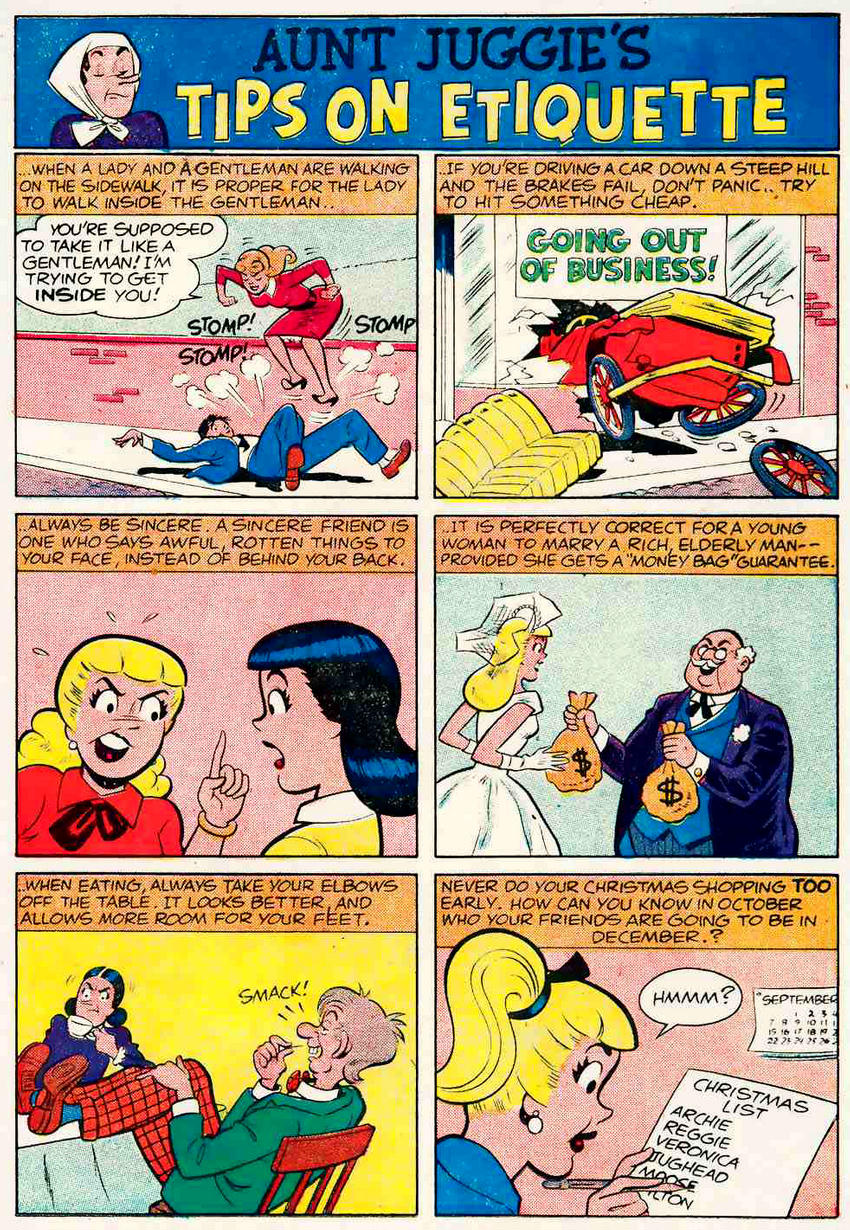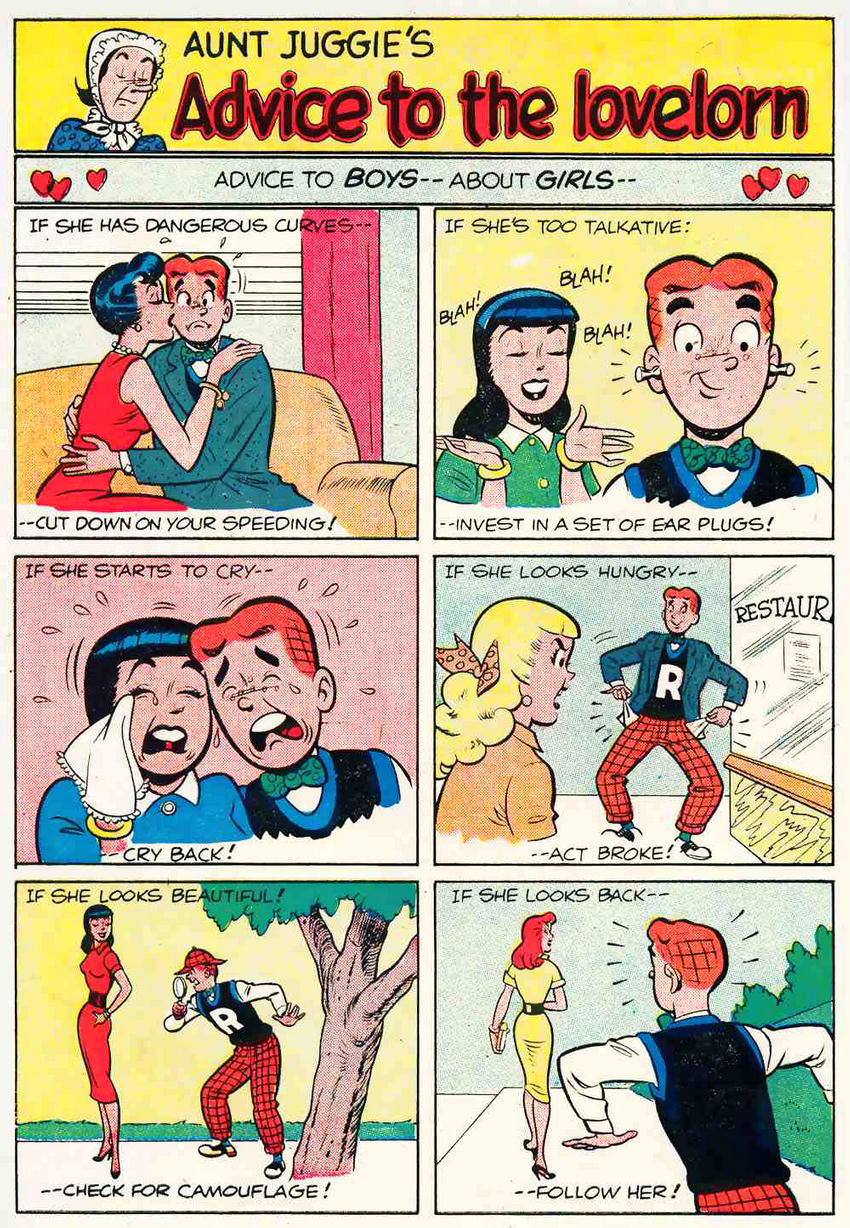I bought the first few issues of Archie’s Madhouse off the comic rack when they were published. I liked all satire magazines, Mad and its imitators. Humor is a subjective thing, though, and after a while I found the contents of the Archie publications starting to bore me, so I moved onto other things. But I still enjoyed those early issues in their own way, reporting on the ways of teenagers. After all, at the time I was just short of entering that teenage world.
Archie’s Madhouse (also called “Mad House” on the cover, even though the indicia has it as one word) has a publishing history that would give a genealogist gray hairs. It was Archie’s Madhouse for 66 issues, Mad House Ma-ad for 4, Mad House Ma-ad Freak-Out for 2, Mad House Glads for 22, and finally just Mad House (which included some horror-style anthology issues) until winding up its run after a final 36 issues. Luckily someone has done the hard work for us, and the whole family tree can be climbed at the Grand Comics Database. Archie’s Madhouse, which debuted in 1960, went on for over 20 years under various titles, but with a continuous numbering through issue #130 in 1982.
This is issue #4 (1960) in its entirety.
Friday, August 29, 2014
Wednesday, August 27, 2014
Number 1623: John Severin strongs to the finich
The recent suicide of actor/comedian Robin Williams got me searching for a satire on Popeye, his first starring movie role from 1980. Both Mad and Cracked took their shots at the movie. Both used their regular movie artists, John Severin at Cracked, Mort Drucker at Mad. I’ve chosen Severin’s version, “Poopeye,”* from Cracked #179 (1981) to post.
Reviews on Popeye have been mixed. Because of his success on television Williams’ performance was under a microscope, and both Mad and Cracked pointed out his “muttering.” (What? They never saw any Popeye animated cartoons, with Popeye’s muttered asides?) I also have mixed feelings about the movie. There are problems translating a character conceived as comic art to live action. In my opinion it succeeded on some levels,** missed entirely on others. The Cracked opinion of the movie is negative. However, Severin’s likenesses of the actors are, as always, right on.
*“Poopeye” was also used as a title in Mad #21.
**At the time the general consensus from my circle of friends was that Shelley Duvall was born to play Olive Oyl.
Reviews on Popeye have been mixed. Because of his success on television Williams’ performance was under a microscope, and both Mad and Cracked pointed out his “muttering.” (What? They never saw any Popeye animated cartoons, with Popeye’s muttered asides?) I also have mixed feelings about the movie. There are problems translating a character conceived as comic art to live action. In my opinion it succeeded on some levels,** missed entirely on others. The Cracked opinion of the movie is negative. However, Severin’s likenesses of the actors are, as always, right on.
*“Poopeye” was also used as a title in Mad #21.
**At the time the general consensus from my circle of friends was that Shelley Duvall was born to play Olive Oyl.
Monday, August 25, 2014
Number 1622: Two vampires and a werewolf
These three tales from pre-Code Atlas horror comics feature three very distinctive artists. Russ Heath drew “The Village Graveyard,” which originally appeared in Adventures Into Unknown Worlds #4 (1952). My scans are from the reprint in Marvel Comics’ Giant-Size Chillers #1 (1974).
Matt Fox drew “I Was a Vampire” for Uncanny Tales #6 (1953), which was reprinted in Giant-Size Dracula #2 (1974). While lacking the professional polish of Atlas artists like Heath or Everett, Fox’s oddball art has an eerie quality. His stiff figures (“stiff” has more than one meaning here) is instantly recognizable. Fox did work for Weird Tales, and had his detractors. Ray Bradbury, for one, referred to “Those terrible Matt Fox horror covers” [for Weird Tales].* But as much as I admire Bradbury, I disagree with his opinion of Fox.**
Finally, the aforementioned Bill Everett did a werewolf story for Menace #9 (1954), in a tale of a dog-hater who has the bite put on him.
*Becoming Ray Bradbury by Jonathan R. Eller, page 91.
**More Matt Fox, this time inking Larry Leiber in some early '60s Marvel Comics. Just click on the thumbnail.
Matt Fox drew “I Was a Vampire” for Uncanny Tales #6 (1953), which was reprinted in Giant-Size Dracula #2 (1974). While lacking the professional polish of Atlas artists like Heath or Everett, Fox’s oddball art has an eerie quality. His stiff figures (“stiff” has more than one meaning here) is instantly recognizable. Fox did work for Weird Tales, and had his detractors. Ray Bradbury, for one, referred to “Those terrible Matt Fox horror covers” [for Weird Tales].* But as much as I admire Bradbury, I disagree with his opinion of Fox.**
Finally, the aforementioned Bill Everett did a werewolf story for Menace #9 (1954), in a tale of a dog-hater who has the bite put on him.
*Becoming Ray Bradbury by Jonathan R. Eller, page 91.
**More Matt Fox, this time inking Larry Leiber in some early '60s Marvel Comics. Just click on the thumbnail.





























































